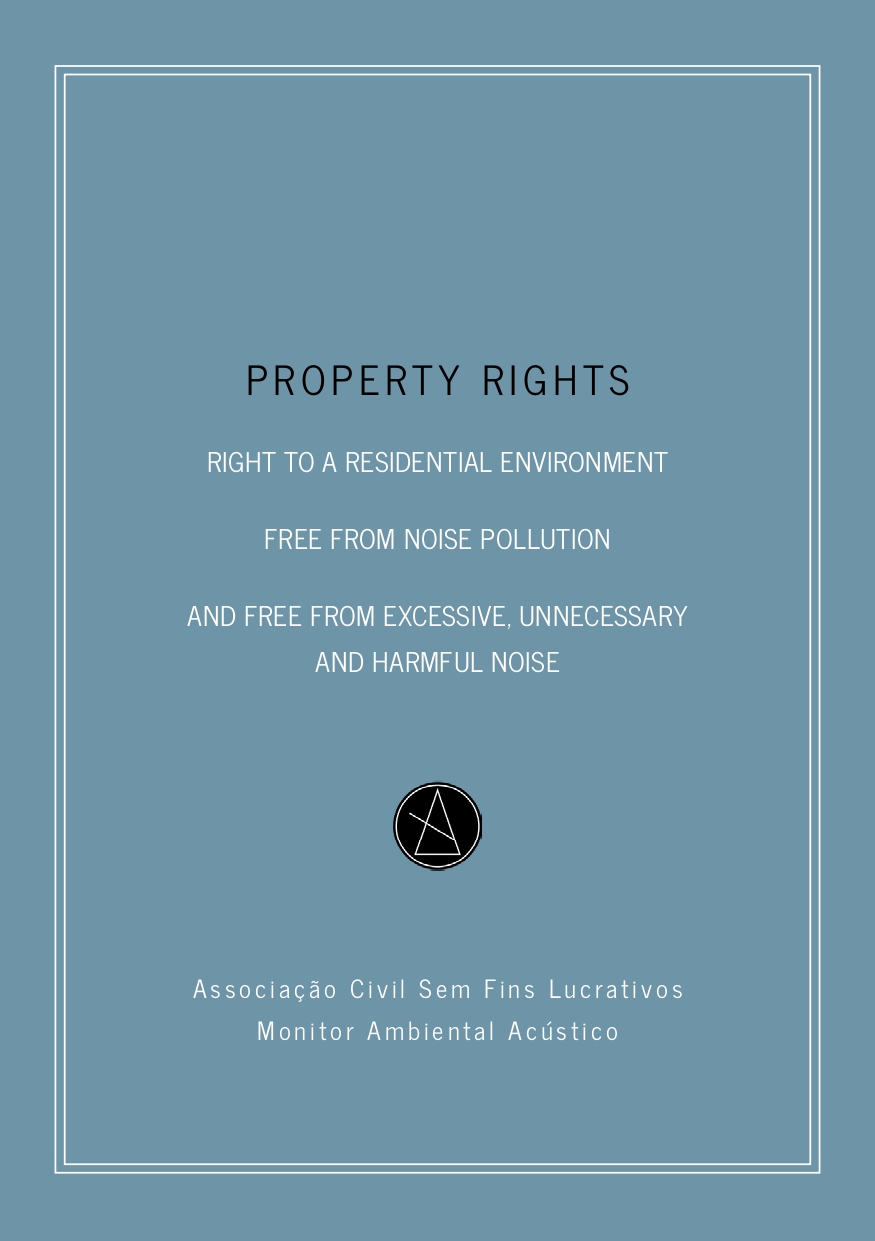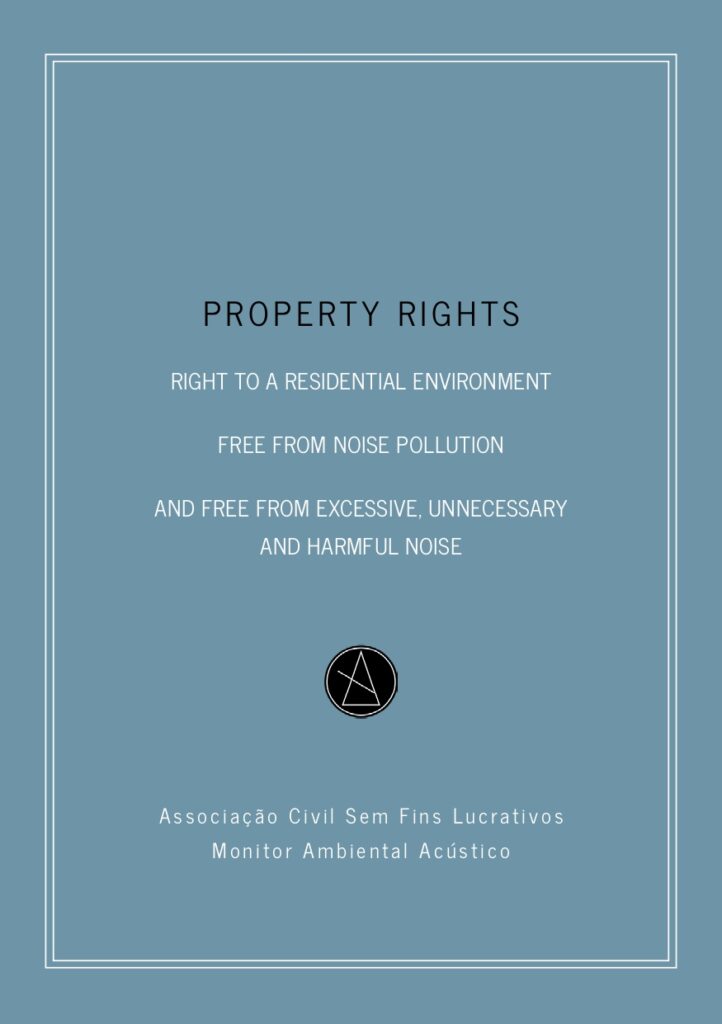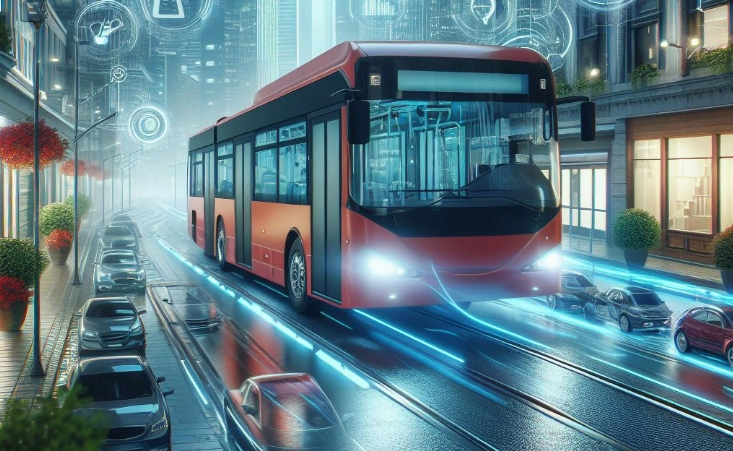Ericson M. Scorsim . Lawyer and Consultant in Public Law. Founder and CEO of the Anti-Noise Environmental Monitor Association. Author of the Ebooks Healthy and sustainable cities, free from noise pollution. [1]And Healthy and sustainable residential buildings, free from noise pollution.[2]
Noise pollution generates immense costs, damages and losses. [3]Within this context, the emission of excessive, unnecessary and harmful noise causes various costs, damages and losses. Economic doctrine uses the term externality to deal with environmental pollution. Now, externality is an arbitrary action, through the imposition of excessive, unnecessary and harmful costs to third parties. A new economy is needed, freeing it from the polluter and the pollution and from the costs, damages and losses caused by these two factors. The emitter of noise pollution must respond to all the economic, environmental and health costs caused to people and society. A sustainable economy is needed that adequately considers environmental assets and the environmental costs and benefits for their protection.[4]
It is urgent to design a sustainable economy, with acoustically sustainable products and services. It is urgent to design the new sustainable economy economically, with alignment between economic value and environmental value. The sustainable economy demands the appropriate valuation of natural capital, represented by the natural sound environment. It is urgent to price the costs, damages and losses of business models that cause environmental noise pollution. And the risks of damage to the natural environmental noise capital. There are inefficient and unsustainable structures and functions. They are authoritarian and degrading structures and functions. It is urgent to reengineer the industry and products with the power to emit excessive, unnecessary and harmful noise. The evaluation of investments and businesses must price risks associated with noise pollution. The business model must incorporate the valuation of environmental costs associated with noise pollution. It is urgent to price the hidden costs of failures of equipment, machines, tools, used in works and services, which cause excessive, unnecessary, harmful and damaging noise emissions. The starting point is the following premise. According to the World Health Organization, noise emissions above 50 dB (A) are a risk factor for harm to health. In addition, for traffic and transportation, the World Health Organization states that the noise emission limit during the day should be 53 dB (A) and at night 45 dB (A). These parameters should serve as quality indicators for environmental, urban, traffic and health management in cities.
There are economic costs associated with environmental noise pollution, such as the loss of productivity for companies due to disruption in workers’ cognition. Excessive, unnecessary, and harmful noises cause stress to the human body. Therefore, this is a sufficient reason in itself for companies to engage in the reduction of noise pollution in the city, demanding that the municipal government take measures to eliminate and reduce noise pollution. There is also the impact of environmental noise pollution on property rights. Properties lose economic value due to the depreciation of property values. Even properties in commercial areas are impacted by areas subject to environmental noise degradation. Imagine a company and a building construction site in its vicinity. These construction sites usually take more than two years to complete. During this period, the company will be affected by the noise pollution from the construction site. And, after the construction site is completed and the commercial spaces are sold, there will be individual construction sites within the commercial building. And what’s more, imagine a residential condominium and, without its neighbors, the construction of yet another residential building. For more than two years, residents of the residential condominium will be impacted by the noise of the construction. Then, to make matters worse, when the apartments are sold, new residents will move into the building and install furniture and decoration.
And the cycle of noise pollution continues, with endless construction work, whether in a condominium or in a neighboring condominium, and so on. And there is also noise pollution caused by traffic. Vehicles that pollute the environment, mainly irregular motorcycles, circulate throughout the city. There is also noise pollution caused by public passenger transport buses. These buses cause degradation of the sound quality of commercial and residential areas. This is yet another reason to demand urgent measures from the local government to replace buses with combustion engines with buses with electric engines. This is yet another reason for property owners and investors to act by demanding measures from the local government to eliminate noise pollution. Economic studies demonstrate the economic value of an environment with quiet and peace . On the other hand, they show the loss of economic value caused by noise pollution. Residential areas impacted by noise pollution lose economic value. Therefore, the degradation of sound quality is a factor that causes economic costs. unfair. This awareness about what environmental sound quality is and what is degradation of environmental sound quality is fundamental.
Environmental sound quality requires standards of acoustic environmental governance, acoustic environmental sustainability and acoustic environmental eco-efficiency . Clarity and precision regarding environmental sound quality indicators and environmental eco-efficiency and environmental sound sustainability indicators are essential. Therefore, the lack of technical quality of equipment, machinery, products and services is a factor in the degradation of environmental sound quality. On the other hand, for those who can afford it, noise pollution increases the costs of measures to promote acoustic insulation, in commercial and residential environments. There are human costs with the degradation of environmental sound quality caused by noise pollution. There are costs to private life, health, privacy, well-being and economic comfort. People lose the conditions of environmental well-being and economic well-being because of noise pollution. Noise pollution is a factor that generates economic costs to human health. There are psychological and biological effects caused by noise pollution. The human body and mind are severely impacted by the emission of excessive, unnecessary and harmful noise. [5]People affected by excessive, unnecessary, harmful noise are unfairly forced to spend money on medical consultations and/or medication to alleviate the effects of stress caused by noise pollution. There are social costs associated with noise pollution, due to the increase in social conflicts and the consumption of vital resources over time. There are environmental costs associated with the degradation of the noise environment. Therefore, measures are required to “clean up the noise environment”, with measures to eliminate, reduce and isolate the emission of excessive and unnecessary noise. There are costs for the defense of people affected by noise pollution, costs for lawyers, access to justice, and costs for producing evidence. There are public costs associated with activating the municipal government, the judiciary, and police and security forces to adopt the appropriate procedures to resolve the problem of noise pollution. Public values are destroyed because of noise pollution, such as sound environmental quality, public health, public well-being, and public peace and quiet.
Noise pollution and the emission of excessive, unnecessary noise are violence against the environment and violence against the physical, biological and psychological integrity of the human person . Therefore, in extreme cases it is necessary to call upon the justice authorities to investigate the crime of environmental noise pollution (art. 54, of the Environmental Crimes Law) and the criminal offense of disturbing work and peace (art. 42, item II, of the Criminal Offenses Law). There is a lack of indicators to measure the effectiveness of criminal law against polluters, offenders and emitters. On the other hand, as for the damages caused by the emission of excessive, unnecessary, harmful and abusive noises, there is the following classification. Economic damages caused by noise pollution to economic and social activities are immense and diffuse. Therefore, there are patrimonial damages that must be duly repaired by the person who caused the damages and by those who fail to prevent and control the emission of excessive, unnecessary noises. However, there are methods for calculating these economic damages. Methods for determining losses associated with noise pollution; loss of use value of areas, loss of hedonic value, among others. Here, the polluter pays principle must be applied; the polluter must pay all economic damages in full. There is damage to work and the work environment caused by the emission of excessive, unnecessary noise. People who perform work of an intellectual nature are severely impacted by the emission of excessive, unnecessary, harmful and damaging noise. There is damage to private autonomy, private life , personal damage, caused by the invasion of excessive, unnecessary noise, to the human body. There is compromise to the person, their personality and their rights; there is damage to the free development of personality. There are damages to neuroatypical , neurodiverse and neurodivergent people , vulnerable to exposure to noise . [6]There is environmental damage caused by noise pollution; there are also methods for this calculation.
Polluter pays principle also applies here ; the polluter must pay in full for environmental damages. Another point is that the authority that fails to prevent environmental damage is jointly liable for environmental damage. There is damage to biodiversity and fauna. Animals are severely impacted by noise pollution. Excessive, unnecessary noise impacts the natural habitat of birds. There is psychological damage caused by the emission of excessive, unnecessary, harmful noises. As mentioned, excessive noises generate psychological and psychological effects. There is damage to human health, with excessive noises generating the stress hormone, and having an impact on the cardiac, digestive, and sleep systems, among others. There is damage to people’s physical and mental health , caused by noise pollution and the emission of excessive, unnecessary noises. There is damage to education and the teaching and learning process with the emission of excessive, unnecessary, harmful noises. Concentration and cognitive activities are impossible in the context of excessive and unnecessary noise emission caused by equipment, machines and tools used in construction and services. There is damage to the culture of quality, culture of stillness, culture of tranquility, culture of well-being, culture of environmental sustainability, culture of non-violence, culture of peace and intellectual culture. There is damage to environmental aesthetics and the right to a natural environmental soundscape. There is also damage to environmental ethics with the antisocial, illicit conduct of causing damage to the quality of the sound environment . The emission of excessive and unnecessary noise is a symptom of underdevelopment; it is a type of toxic subculture of environmental contamination and degradation. There is existential damage caused to the person by restrictions and limitations imposed unfairly and illicitly. The person has their freedom in their life project sacrificed because of the polluter. There is moral damage to be imposed on the person causing the emission of excessive, unnecessary and harmful noise. The pain and psychological suffering caused by the emitting agent must be fully repaired. Here, there is an ethical dimension, the determination of moral damages must be determined with an educational function in mind and to dissuade the repetition of illicit conduct. and abusive. Regarding the losses caused by noise pollution and the emission of excessive, unnecessary, harmful and damaging noise. There are losses of opportunity for companies, owners, investors, residents, citizens. There are economic losses, property losses, job losses, rest losses, health losses, environmental losses, cultural losses.
To avoid costs, damages and losses due to excessive, unnecessary and harmful noise emissions, there are several possible solutions . Directly hold those responsible for environmental noise pollution and excessive, unnecessary and harmful noise emissions accountable. In the case of manufacturers of equipment, machines and tools used in services and construction, directly hold the manufacturer of the product that is harmful to the environment and to health and the quality of private life, well-being and comfort accountable. Hold the manufacturer responsible for flaws in the mechanical design of the equipment, machinery and tools, and point out mechanical and/or electrical negligence of the industrial product. Point out flaws in the acoustic quality of the product. Hold the manufacturer, seller and trader responsible for environmentally unsustainable practices and misleading advertising. In the case of building constructors, hold the constructor directly responsible for environmental damages in neighborhood relations and to owners and residents. Directly hold condominiums and their service providers responsible for construction work that causes environmental noise pollution and excessive, unnecessary, harmful and damaging noise emissions. Hold motorcycle drivers who cause environmental noise pollution accountable, with the application of legal sanctions such as impounding the motorcycle and imposing severe fines. In the case of public passenger transport buses, hold the company and the city government directly responsible for environmental damage, economic damage, property damage, and health damage, damage to mental health, damage to well-being and comfort, among others. In the case of municipal services that pollute the environment and emit excessive, unnecessary, harmful noise, hold the city hall and the company providing the service responsible. Also, hold the city hall responsible for failure to supervise works, services, traffic and public passenger transport. Educate consumers and citizens so that they are informed about the acoustic quality standards of products and services.
Another point is the adequacy of adequate taxation to deter antisocial and environmentally unsustainable behavior. And also to encourage development. Also, policies to encourage the manufacture and use of clean, healthy and sustainable technologies, with zero noise emissions . Encourage technologies for monitoring environmental sound quality and preventing and controlling noise pollution. It is necessary to update environmental legislation to enshrine the principle of environmental acoustic eco-efficiency and the principle of environmental sound sustainability, as well as to encourage the use of technologies for monitoring environmental sound quality (acoustic radars and acoustic chambers), as well as the use of clean, healthy and sustainable technologies, with zero noise emissions. It is necessary to implement the polluter pays principle, with effective measures to impose severe sanctions on environmental sound polluters. Adopt environmental acoustic governance indicators. For the public sector, especially for city governments, to adopt environmental sound quality indicators, with measures for preventing, managing and controlling noise pollution. Indicators to measure the city’s environmental sound quality, street sound quality, traffic sound quality, public passenger transport sound quality, airspace sound quality, residential sound quality, residential sound quality, among others. As mentioned, the environmental sound quality indicators must be associated with the rates of compliance with the noise emission limits in the transportation and traffic sector of 53 dB (A) during the day and 45 dB (A) at night. The indicators must also be associated with the presence of technologies to monitor environmental sound quality: noise maps, acoustic sensors, among others. The history of social transformation movements has countless successes, from campaigns against “smoking”, campaigns for the use of safety fives in vehicles, campaigns to restrict alcohol consumption while driving, campaigns to control vehicle speed on streets and highways. Now is the time for the campaign to eliminate and reduce noise pollution and the emission of excessive, unnecessary, harmful and damaging noise, to guarantee life, quality of life, environmental quality, health, private life and privacy, well-being and safety of all, as well as to promote the inclusion, protection and promotion of the rights of neuroatypical , neurodiverse and neurodivergent people , vulnerable to excessive, unnecessary and harmful noise.
You can also join this movement. To learn more, visit: https://antirruidos.wordpress.com/
[1]Available on Amazon.com . Acoustic Environmental Sustainability: The Right to Cities Free from Noise Pollution
[2]Available on Amazon . Healthy and sustainable condominiums, free from excessive noise and environmental noise pollution .
[3]This study is based on knowledge in systems theory, ecosystem theory, systems change theory, theory of institutions and institutional innovation, systems engineering theory, theory of command and control systems, intelligence and communications, quality theory, ecodesign theory , behavior change theory, engagement theories, theories of perception and cognitive dissociation, theories of industrial innovation, theory of sustainable economy, theories of sustainable development, theory of environmental peace, theory of polluter pays, theory of environmental eco- efficiency and environmental sound sustainability.
[4] See : Tientberg , Tom and Lewis, Lynne, Lewis. Environmental and natural resource economics . New York and London, 2018.
[5]The human body has dimensions: solid, liquid and gaseous. In other words, the body has parts of bones, muscles, water and air. For this reason, it is extremely sensitive to noise pollution and acoustic vibrations.
[6]Example: people with autism spectrum disorder, misophonia , hyperacusis , anxiety and depression, hyperactivity, attention deficit, among others.











